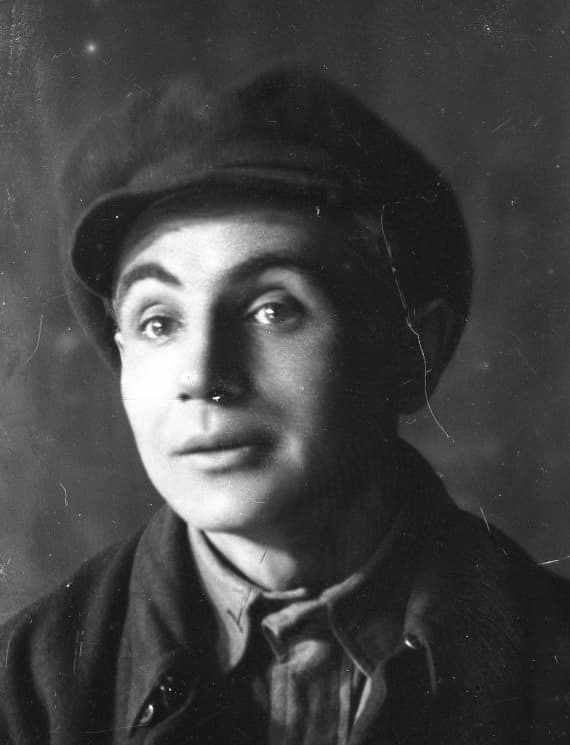Based on the play by Mykhailo Starytskyi
Scenario by Vasyl Vasylko, Khanan Shmaiin
Script by Volodymyr Yaroshenko, Pavlo Shcherbatynskyi and Liudmyla Starytska-Cherniakhivska
Premier: February 25, 1925
Director: Vasyl Vasylko
Artists: Valentyn Shkliaev, Maiia Symashkevych
Sirko, Mill Tenant – Serdiuk
Sirkova, His Wife – Steshenko
Pronia, Their Daughter – Hakkebush, Chystiakova, Dobrovolska
Khymka, Sirko’s Handmaid – Neshchadymenko, Lor
Lymerykha, Sirko’s Sister, Seller – Babiivna, Pylypenko
Halia, Her Daughter – Tytarenko
Holovkhvostyi, Swindler, Head of Industrial Trade Organization – Hirniak
Kopylevych (His Companion) – Balaban, Savchenko
Supchyk – Makarenko, Radchuk, Podorozhnyi
Sharmanshchyk, Red Invalid – Karpenko, Ivashutych, Balaban
Thief – Nazarchuk
Bobchyk – Shutenko
Dobchyk – Ivaniv
Sellers – Smereka, Petrova, Stanislavka, Dotsenko, Pihulovych, Krynytska, Kosakivna, Vereshchinska
Shopkeepers – Drobinskyi, Bilashenko, Romanenko, Havryshko, Zhadanivskyi, Vostochnyi
Head of the Club – Babenko
Zalizniak, Director – Krushelnytskyi, Karpenko
Petro, Actor-Slacker – Masokha
Voznyi – Svashenko
Vybornyi – Kononenko
Terpelykha – Kuzmenko, Pylinska
Policeman – Shahaida
Invalids – Drobinskyi, Kononenko, Romanenko
Deacon – Shahaida
Nun – Krynytska, Kuzmenko
Sailor – Masokha
Vustia – Smereka, Stanislavska
Motria – Petrova
Townsman – Stetsenko
Hairdresser – Khodkevych
1st Bridesmaid – Dotsenko
2nd Bridesmaid – Pihulovych
NEPmen – Podorozhnyi, Zhadanivskyi
Chasing Two Hares, based on Mykhailo Starytskyi’s play, appeared on the stage of the Berezil Artistic Association in 1925. The premier, directed by Vasyl Vasylko, took place on February 25 – Les Kurbas’s birthday. Starytskyi’s original text was significantly rewritten and modernized by several authors. As noted in the playbill, the scenario was written by Vasyl Vasylko and Khanan Shmaiin, and the script was written by Volodymyr Yaroshenko, Pavlo Shcherbatynskyi and others. According to theater critic Valeriian Revutskyi, one scene was written by Starytskyi’s daughter, the well-known writer Liudmyla Starytska-Cherniakhivska. Vasylko’s diaries confirmed this.
At the time, adaptations of classics were common and popular. Critic Yurii Smolych in his review in 1926 didn’t deny that some adaptations were successful and understood their advantages, but noted that the text, written in the heat of the day, quickly gets old. “The first act (at the market) already needs a thorough update and its gags need a good revision. They stink of [19]22-24, rather than 26-27.” And he went on: “This may seem like a paradox, but sometimes the new text seems older than Starytskyi’s text.”
The goal of the director and actors of the modernized version of Chasing Two Hares was to create a satire that hit the mark, so they set the play in the NEP environment of then Kyiv, the residents of which were mostly negative characters: NEPmen, swindlers, speculators and losers. Vasylko wrote: “Satire has to be sharp and clear to hit the mark. Satire allows for exaggeration. That is its nature. I wanted my delivery to have lots of laughter, not humor or irony, but sarcasm. I understood that my idea was a lofty goal, but I really wanted to my show to reach that ‘condition.’”
Starytskyi’s characters underwent major changes in Berezil’s stage version. Holokhvostyi was no longer a barber, but the head of the Industrial Trade Organization who pretended to be disabled and hid that he had been kicked out of the communist party. The scriptwriter found the inspiration for this colorful biography from a newspaper report about members of an association that used disability benefits to illegally engage in trade.
The “overripe girl” Pronia, according to Vasylko, was renamed Yefrozia, and belonged to a theater club where she rehearsed the role of the “revolutionary communist” Natalka in the “traditional” play by Kotliarevskyi.
There were also new characters in the show: speculators Kopylevych and Supchyk, director Zalizniak, and perhaps the only positive character – invalid Sharmanshchyk, who ridiculed human defects and whose documents Holokhvostyi stole. In one of the scenes, director Zalizniak stages Revolutionary Natalka Poltavka, wanting to outdo Meyerhold who in 1923 staged the popular The World Turned Upside Down at the Meyerhold Theatre. The artist, played by Marian Krushelnytskyi, appeared on stage with lush red tousled hair, smashed his glasses and screamed from the emotions that overwhelmed him during rehearsals: “Meyerhold’s world turned upside down and mine is going to get on all fours!”
The show’s director, Vasyl Vasylko, wanted to bring the actor to the fore. Before the premier he was quoted by a newspaper as saying: “In Chasing Two Hares the director attempts to move directorial elements to the background and puts the actors to the fore as the main element of the theatrical performance.” Smolych noted that the acting ensemble doesn’t completely live up to previous Berezil shows but wrote that most “characters are believable and lively.”
Critics singled out Hirniak (Holokhvostyi), Dobrovolska (Pronia), Balaban (speculator Kopylevych) and Krushelnytskyi (director Zelizniak) for giving outstanding performances. Pronia was first performed by Vaylko’s wife Liubov Hakkebush. The actress didn’t see herself in this role but Vasylko insisted that she play it. The result didn’t work out: Pronia’s Hakkebush receded into the background and got lost among the more brilliant characters.
Vasylko had a good creative tandem with Valentyn Shkliaev, the artist who worked on Chasing Two Hares. According to the director’s memoirs, he “often sat through the rehearsals and watched how the actors move, studied their bodies and how they walked, and only then sketched their costumes.” Artist Maiia Symashkevych also worked on the play. Theater critic Petro Kravchuk wrote that the set design was based on a principle of transforming machines and elements in a way that allowed the actors to play certain episodes in an interesting way: “slippery sloping grooves hung from a tall machine, and actors during a chase, for example, slid down to the flood standing up, lying down or sitting up, and sometimes in similar situations they tried to climb up the slippery slope. This created a number of colorful situations, added dynamism and lightness to the mise-en-scène.”
The play ended with a “live scene” where all the characters simultaneously wore fakes noses, visualizing the phrase “left looking like a fool.” In the final scene Holokhvostyi would run off to the parterre telling everyone that they are now bankrupt. The characters, having taken off their noses, ran after him, asked the audience to detain the swindler, looked for him in the boxes, on the ground floor and in the gallery, but then the focus switches from Holokhvostyi to the spectators and society, where “he still is!” The play ended with this verdict.
Before the premier there was a conflict in Berezil. The theater’s directorial staff was against the show going on, especially without Kurbas, who was in Odesa at the time. In his diaries Vasylko wrote bitterly: “Things are very bad, I am completely alone: the directorial staff is against me, the political committee got scared and sent a telegram to Kurbas telling him to take responsibility and immediately come back, the director trainee is still a child…” Kurbas wrote a telegram back saying that he felt delaying the premier was unnecessary. According to Vasylko’s memoirs, the head of Berezil had many concerns about the show but told him nevertheless that it was a “…good, brilliant work.”
Despite the skepticism within Berezil, the show was very popular with the audience and after it Vasylko, so to speak, woke up famous. Thanks to the Hares, after a few months he became one of the most popular directors in Ukraine and became so close with them that after leaving Berezil he put on the play that made him a huge success in three different theaters.

